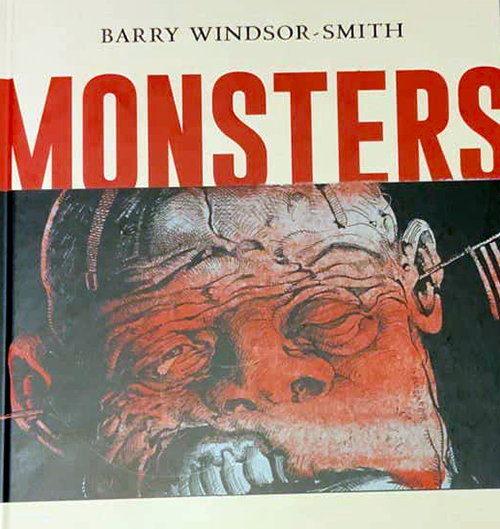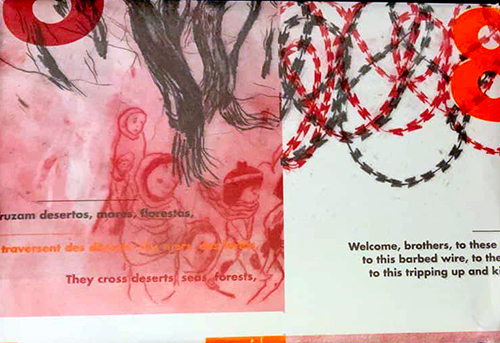Let’s start with some Manga. No 5 by Taiyo Matsumoto is finally being published in English! The first 2 books in the series was published long ago and it was my first discovery of Matsumoto. My first impression was that it was a Japanese comic with heavy influences from Moebius and US action comics. After reading more of him, that impression has evolved into just a love of his line work and a form of naivistic expression that somehow turns into realism without looking like realism. It’s hard to describe properly but I want it! I mean I want to be able to do the same thing. Those hands, those faces, that sense of movement, his use of shadows under water!
The first edition of No 5 never continued after those first books in English. More came out in French, but I’m not sure even those editions covered the whole series. Anyway, now it’s coming, the whole thing in 5 volumes from VIZ Media. The 2 earlier both fit in the first of the new ones, which is all I’ve read so far.
Another classic(?) manga is Opus, by Satoshi Kon, who is mostly known for is work in anime such as Paranoia Agent, Perfect Blue and Paprika. Opus is a meta story of a manga artist ending up within his own comic. I’m not sure what I thought of. I guess it was ok, it’s an early work by Kon and was left unfinished for years. Not as interesting as what he did later, but nice to see where he came from.
On the other hand, I re-read the first volumes of Samurai Assassin by Kazuo Koike and Goseki Kojima, and that’s never a bad idea.
I finally got around to reading Palestine by Joe Sacco. I’ve been putting it off because I thought it would be emotionally taxing. Which wasn’t wrong, but sometimes it’s worth it to learn more, even about things you already kind of know. If you don’t know already, Palestine is Sacco’s journalistic report about Palestine, first published in the mid-1990s. Lots of mud and misery and people who have been in Israeli prison camps. Stories of torture and resistance.
I went on to read Footnotes in Gaza (also by Sacco), which is more specific in its subject, concentrating on one part of the conflict, showing both the current (when the book was written, a bit over 10 years ago) situation in Gaza with the constant and mostly arbitrary bulldozing of people’s houses, and researched events from the earlier days of the occupation, all based on eyewitness accounts and some comparisons with official documents. From the inception of Gaza as a refugee camp created by people who had been driven from their homes by the Israeli occupation to a couple of events on the way to the now of ca 2009.
Is “nazi-esque” a word? I think it’d be a good description of the mass murders depicted in this book. It gives a broader image of daily life in Gaza now and then. However, the main event is a massacre that took place in Rafah in 1956, where all the men were rounded up, driven like cattle to a schoolyard, and my words can’t do it justice in the same way the comic does. Hundreds of civilians were systematically murdered and whoever says that the situation is too “complicated” to choose sides is by default an apologist for things like this. Read it.
Zombier, zombier, zombier is a Swedish non-comics anthology about zombies, from different perspectives. Some more interesting than others. Best was the text by Mathias Wåg who wrote about zombies as allegory for popular mass movements and how they have been seen and depicted historically.
More non-comics (before we go back to the more advanced form of literature that is the picture-book): Exterminate all the Brutes (orig: Utrota Varenda Jävel) and the sequel The Skull Measurer’s Mistake: And Other Portraits of Men and Women Who Spoke Out Against Racism (orig: Antirasister: människor och argument i kampen mot rasismen 1750-1900), both by Sven Lindqvist (I read them in the wrong order, one in Swedish and one in English, but it doesn’t matter). Both highly recommended.
Exterminate all the Brutes is an examination of Joseph Conrad, his book Heart of Darkness, and the time and social climate that surrounding him. Which means it’s about European colonialism, primarily in Africa, during the 1700-1800s and a bit into the mid-1900s.
We tend to treat the Holocaust as a unique event. Lindqvist that it’s not unique at all, just a logical continuation of things that happened in the European discourse of the preceeding centuries. The main difference between the Holocaust and the earlier colonialism was that it took place within Europe. But the ideas it was based on were things like some races being obsolete and ripe for extinction, races being both biological and cultural, the need for space for the superior race to expand and flourish. These ideas fall apart when you look closer at them (as should be, but isn’t, apparent for everyone nowadays), but they were totally dominant during that period, enabling for example the genocide in Leopold II’s Congo and other atrocities that cost millions of lives.
Which becomes even more clear in Antirasister (I’m using the titles in the language I read the books). It explores documented instances of people who questioned the paradigm of White supremacy. White supremacy sounds like an extremist view these days, but not long ago it was simple the generally accepted truth to the extent that it didn’t even need to be said out loud most of the time. Even the dissenting voices were affected by the paradigm. Most examples are things like someone figuring out that Jews should be regarded as people too, but forgetting the extend the same courtesy to Native Americans. Or someone writing an article against slavery that no one really took seriously. Small, individual drops against an ocean of racism.
If things go as planned, I will be involved in an exhibition working with this themes later this year, so I will be sharing some more thoughts and insights about it then. By the way, Exterminate all the Brutes also exists as a documentary series on HBO Max that I plan to watch at some point.
Back to comics, but sticking with the nazis… Monsters by Barry Windsor-Smith was originally meant to be an alternate take on The Hulk, something like Windsor-Smith’s Weapon X that redefined parts of Wolverine’s backstory, but that never happened. Instead, it was recently released as its own graphic novel, published by Jonathan Cape/Penguin Random House. It’s a black/white story, written and drawn by BWS, dealing with child abuse, military science experiments, and nazi scientists imported to the US after the second world war. In short: monsters and monstrosities. By an artist who still lives up to the hype.
Another classic comics creator is Charles Burns, probably best known for Black Hole. Last Look is a collection of 3 books from a period of about 10 years. Maybe not as captivating as Black Hole, but that could be because this is a much shorter story. In short, it’s about this guy who is bad at relationships. It’s also told in a non-linear way with lots of dream sequences. It all comes together very satisfyingly.
Shaolin Cowboy: Who’ll Stop the Reign by Geoff Darrow brings more details and crazy fights and a big altright pig. We just can’t seem to get away from that theme in this post, can we? Anyway, Darrow is crazy as usual and seems to really truly enjoy drawing comic panels that other artists would run from, screaming in panic.
More visual storytelling: The Thousand Demon Tree by Jeffrey Alan Love is all about the visuals. Large format and amazingly stylized, it tells a story that evokes a sense of grandiosity that is quite similar to some scenes in the game Shadow of the Colossus.
Meanwhile, The Arrival by Shaun Tan is (mostly) much more low-key. Like The Thousand Demon Tree, it’s told only in images with no text and is a story about migration in what seems to be a fantastical version of old-school New York, from the era of “bring me your huddles masses”. That feeling, but with fantasy animals and architecture and weirdness.
Speaking of migration… I don’t think I’ve written before about Club Mediterrâneo – doze fotogramas e uma devoração? Based on a poem by João Pedro Mésseder, it’s illustrated by Ana Biscaia with typography by Joana Monteiro. Ana and Joana were guests at AltCom 2018 and brought this book with them. Just wanted to mention it because it’s a very nice book about a not-so-nice situation for refugees coming to Europe over the Medierranean…
Oskar Aspman, one of my co-founders of CBK, recently used the risograph at the Malmö University to print Nightshine, a zine version of an old comic from C’est Bon, but remixed with new color and halftone and resurrected text from his original draft. Very nice, halftone-y and his usual kind of dirty line work.
Also re-read the Piracy is Liberation books by Mattias Elftorp (name sounds familiar somehow) recently. I’m happy and relieved that they still hold up. I did it mostly as research since I’m getting ready to start working on book 012 of the series, finally, ten years later. Just waiting for my work situation to change so I’m allowed to draw more than 1,77h/week again (long irritating story for another time)…
As you may suspect, I make lists of everything I read. It sounds a bit OCD(?), but is mostly so I don’t forget as easily. It’s also a great help for when I do these annual review posts. And maybe a bit of OCD?
I hope you get something out of it. If you’ve read some of the things I talk about you can figure out something about my tastes, and you can use that to figure out if you should check out some of the things I mention that you haven’t read.
Up next: movies and TV series…











